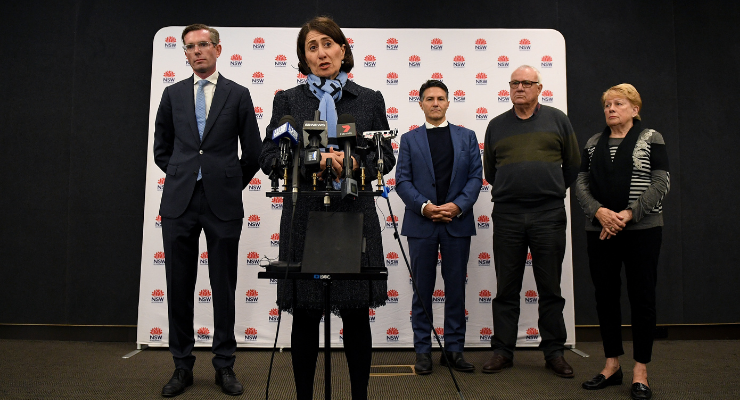
News alert: governments and public authorities have seized control of both “news” and news distribution as they grab the opportunity offered by the pandemic. Journalists? They’re increasingly at risk of being left out, echoing along behind.
But there’s a gap in the news market that political uncertainty makes governments reluctant to fill. It’s looking forward to ask: what’s the post-COVID world? How do we get there?
Australia’s political leaders have taken the knowledge and power that comes with their authority and meshed it with the ubiquity of media distribution (both traditional and social) to bypass journalists. This is the news, 21st century style.
We’re back in the theatre of ancient Greece, where, state by state, the premier and chief health officer (CHO) have strutted centre-stage as the protagonists of the COVID drama. The press corps? They’re the chorus, amplifying through call and response.
It’s increasingly stylised (and slick) as the pandemic rolls on: morning by morning, the double act of state premier (or, occasionally, prime minister) and CHO kick off the news cycle, with a supporting cast from police and lesser ministers. Sometimes, the actors get to play dress-ups in uniform.
It’s news style. The premier gives the headline: cases and tests! The CHO provides the body copy: case by case, in an easy-to-digest what/where/when/why/how framework; journalistic enough to be convincing, amateurish enough to be endearing.
And the police provide the tabloid clickbait: arrests; charges; and the odd irresistible yarn like the NSW one last week about nude sunbathers and a curious deer.
The premier wraps with an editorial-style public service announcement, with a pandering “how great is our state?” twist and (pause, look to camera) a serious grab for radio and TV bulletins.
Much of it is spoken directly to the audience at home, broadcast live. All of it packaged through social media and — in the case of the federal government, at least — repackaged as digital advertisements with party branding.
Live vibe
The journalists still matter, of course. Like any audience, they’re at the show to give the live vibe that makes things real, to throw up the trick questions that let the stars demonstrate how, Houdini-like, they can be free of their bonds with one twist.
The News Corp hostility to Labor premiers has allowed those premiers to reward the company’s reporters and opinionistas with guest roles in the Melbourne and Brisbane season runs.
They’re the antagonist, the moustache-twirling melodrama villains, fulfilling the needs of both News Corp’s market positioning and the premier’s base support. Social media lets the audience play along at home, tweeting out “Watch out! They’re behind you!” or “Go get ’em, Peta!”.
When the audience gets the news they need from government, what’s the job that journalists need to do? Accountability. Context.
Trouble is, it’s a fine line between accountability and gotcha, a line increasingly muddied as Australia’s media, encouraged by News Corp’s enduring ability to agenda-set, trample it back and forth, turning “accountability” into the hunt for someone to blame, feeding at a global scale the (so far mythological) story of the leaky Wuhan lab or, at the local level, last year’s story of Melbourne’s bonking security guard.
It’s fed a COVID-shaming journalism, from last week’s Daily Telegraph front page shot of the gig-working limo driver to last year’s Courier-Mail “Enemies of the state” headline over headshots of two young women blamed for breaking quarantine regulations.
Start the shaming and politicians are often too happy to join in, as Palaszczuk did last week over a 19-year-old casual clerk in her own health system.
It tempts journalists to become snitches, with those inevitably two-dimensional beachfront images used to assert claims about (lack of) three-dimensional social distancing. Instead of using the press conferences to challenge the excesses of COVID-driven policing, journalists urge it on, giving premiers the opportunity to seize what should be the journalistic turf of nuance and context.
It’s encouraged journalists to make the unusual seem common and the unlikely probable. Exhibit A: media reporting on the AstraZeneca vaccine.
This week, we learnt from the prime minister’s announced plan-to-have-a-plan that Australia is still just halfway through what looks set to be a three-year COVID-19 caesura. Time enough to take a beat to ask: how does journalism take back news that our audiences need?








A great lump of these “journalists” have been practicing for these times for years – as “stenographers to government”.
Australia has gone the way of UK and US where the UK ByLine Times cites the clubbiness of journalists with the Tory govt. which ends up becoming a form of protection racket for corruption and sub-optimal ethics, amongst those cooperating on ‘messaging’. If not, a journalist and/or media outfit needs to be prepared for various forms of intimidation from government and other media…..
The open web and social media gives everyone with a story to tell a channel that can reach any audience. That includes public and government institutions. They’ve long had web sites that presented their sides or their stories, and they’re getting slicker, and that’s good.
Surely the job of journalists is to tell the stories that the people with power and influence would prefer not be told? Pointing out inconsistencies and errors in the “official” line isn’t a “gotcha” if the error or spin is material and affects the public in some significant way.
There’s also a role for editing/curating/highlighting, but that role is also being somewhat performed by robots (AKA “algorithms”).
Pretty good summary CW. Thanks.
The answer to your final question is “When they decide they want to.”